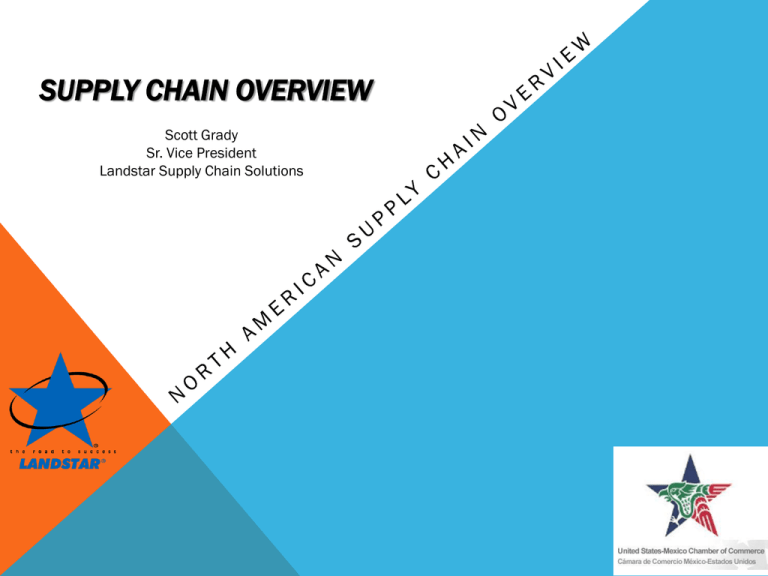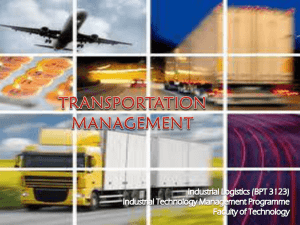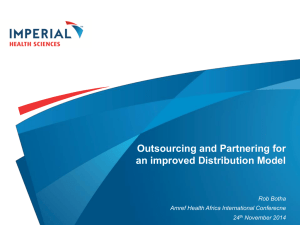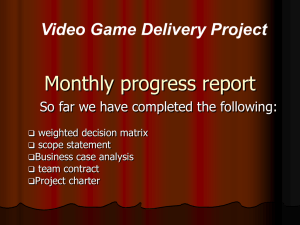Why Outsource your Supply Chain
advertisement

SUPPLY CHAIN OVERVIEW Scott Grady Sr. Vice President Landstar Supply Chain Solutions North American Supply Chain Trends Early 2000’s Globalized Focus – One Product fits all Auto Industry Clothing Agricultural Consumer Electronics – Inventory Floats could be as much as 60 days – Industry carried “Back up inventory” Velocity was Slow NAFTA – North American Focus Limited Global Impact Premature for Infrastructure 2 North American Supply Chain Trends Today Globalization Comes Home – Consumer trends are changing more dynamically Auto Industry Clothing Agricultural – Supplier Trends Near Shoring Campus Environment Tier 1’s are more sub-assemblers than Manufacturing based – Auto – Electronics – Industry carried “Back up inventory” Velocity Extremely Fast and agile Supply base has “right Sized” no excess Capacity NAFTA – Today NAFTA is bringing Manufacturing to the Consumer – Mexico Has Advantage 3 MEXICO Today Mexico Seaports – Intermodal – Strong Infrastructure focus in past 10 years Highway – Infrastructure Upgrades and Rapid improvement – Can Source Regionally Today Growing Consumer Demand Supplier Capacity Workforce Downside – Security Issues – Political Strife – Limited Logistics Expertise (Growing) 4 Changes in Strategy Manufactures Campus Environment (Near Sourcing) – Tier 1’s (sub Assembly) on Campus Parts are sequenced Inventory owned by Tier More capacity at Manufacturing sites Forced Suppliers to Tier 1 – Consumer Electronics Consumer Driven Velocity – Trends drive sourcing choices – Time to Market Consumers tastes change and they want more for their $ Retail-no longer seasonal, but stores are updated every 45-60 days Automobiles, used to be 36 to 48 months concept to dealer floor – Dodge Dart 18 Months Green Environment Risk Mitigation Sustainability 5 Changes in Strategy THEN SupplierSupplier NOW Customer Supplier Supplier Collaborative Suppliers: Supplier Increased LTL Frequency Decreased Lead Time Decreased Inventory Reduced Transportation Spend Supplier Supplier Supplier Customer Supplier Supplier 6 Current Supply Chain Issues Cross Border Visibility Security – High valued cargo – Merchandise easy to sell – Merchandise that is not traceable Expedite – Mexico – US Vendor set-up Very little exchange still of capacity 7 Supply Chain Brief Discussion Design Why Outsource 8 Total Enterprise Solution Reducing Supply Chain Costs and Increasing Visibility Performance Reporting Truck Financial Settlement Master Data, Customer Order Transportation Management System Supply Chain Event Mgmt Global In-Transit Inventory Visibility Rail Level 1 SKU Level Planning Air Level 2 Shipment Planning & Optimization Shipment Execution Ocean 9 The Supply Chain Network The Design Complexity drives the solution – Size and volume does not drive complexity Forecasting integrity – A changing forecast drives Mode change Deviation and route fall off Expedite Visibility is the key – Multiple touch points need to have event marks 10 Network Design Types of Optimization Basic Operational Network Tactical Dynamic Strategic Simple Optimization Evaluation of Cost & Service Options Full Network Optimization Shipment Level Shipment Level Daily / On Going Excel / Access Transportation Modeler Enterprise 11 Shipment Planning and Optimization Support a wide range of optimization needs Optimized Decisions • Consolidation • Service Provider • Timing • Equipment • Route • Mode 1. Loading 2. Warehouse receiving. Storage as required Multi-Leg Multi-Mode Consolidation Common Leg Consolidation Multi Stop Consolidation Multi-Tier Networks LTL Consolidation Continuous Moves 3. Container stuffing 6. International transport (Land, Sea and/or Air) 4. Customs - origin 7. Customs destination 5. Port services - origin 9. Container de-stuffing and warehouse receiving. Storage as required 8. Port services destination 10. Truck loading 11. Final delivery Service Time Calculation 3-Dimensional Container Optimization Itineraries & Profiles Carrier Capacity Throughput Rating 12 Load Configuration Shipment View – – – – Change View Perspective – – – – Increase effective cube utilization Provides detailed loading instructions Reduces failed loads – loads that can not be loaded as planned Inputs to drive utilization include SKU level detail – Stack ability, dimensions (LWH), dunnage Nose Tail Top Side Manipulate, at the ship unit level – All Ship Units By Item By Commodity By Stop – Sequence of loading Orientation 13 TOP 10 REASONS TO OURSOURCE Global Reach – Leverage critical functions – Global resources People, Process and Systems Operating Expenditures (OpEx) Rules – No capital expenditures – Fees are operating costs – No need to show return on equity Innovation and Interoperability – Outsources spend billions a year integrating new technology – Companies can tap into these resources 14 TOP 10 REASONS TO OURSOURCE Service Transparency – As outsourcing has matured however, metrics have become a key indicator of the success – Organizations can benefit from best practices Savings in Labor Cost – The cost of labor in developed countries for high level activities is extremely high – Shifting the location where this work takes place is definitely advantageous depending on the skill set. Centralized Management of Resources and Functions – The ability for outsourcers to consolidate these functions is a core competency that many companies look to leverage. – Commonality across divisions and regions in process 15 TOP 10 REASONS TO OURSOURCE Improving Regulatory Controls – Achieving, measuring and maintaining compliance is a complex and capitalintensive endeavor. Companies with limited compliance resources look to outsourcing for the design, execution and auditing of controls, while allowing companies to retain requisite internal oversight Accelerating Process Maturity – Outsourcing can often become the catalyst to drive business maturity – Outsourcing can drive a set of best practices and recommendations that can be applied across the organization – Process integration is a key enabler to the improved delivery of services, and provides a comprehensive framework for aligning resources to deliver business value and repeatable processes across the Supply Chain 16 TOP 10 REASONS TO OURSOURCE Increased Resources – Companies that need access to new skill sets for project work, mergers and acquisitions and/or to support expansion into a new region, outsourcing can offer a solution. – Leading outsourcing companies can support Strategic direction and develop new capacity as well as having a global reach to a broad talent pool Improving Company Strategic Focus – Letting an outsourcer focus on managing operational functions allows companies to focus more strategically on their core business, saving time and improving efficiencies – Outsourcers today are in the business of driving innovation, managing data centers and applying non-disruptive technologies to help businesses succeed in an ever changing market 17 Solutions Environment Operational Tactical Strategic Focus Shipment / Load Management Evaluation of Cost & Service Options Full Network Analysis & Design Horizon Daily / Weekly 6 Months to 1 Year 1 to 3 Years Tools Transportation Mgmt. Systems Transportation Modeler Supply Chain Strategist 3 to 6 Weeks 3 to 6 Months 18 Cost Reduction and Value Creation Order Optimization Reduce Shipments Mode Optimization Carrier Optimization Least-cost Mode Least-cost Carrier Order Visibility Inventory Reduction Business Intelligence Savings Validation 5 -15% Savings 19 The issues cause a ……. Ripple Effect……. 20 North America Capacity Market Issues Capacity shortage predicted by mid 2013 – Capacity down 7% from 2008 (Source Credit Suisse) – ATA predicts a loss of capacity with CSA as cash strapped companies cannot afford in cab technology TT Asset utilization poor Empty miles are still high Customer leverage deteriorates as rates increase with shortfall – Platform already strained in 1st and 2nd quarter 2012 Natural Disasters – 2011 The year was telling 21 Transportation Industry Today 3.5 3.0 2.5 Shipments (Numbers) 2.0 1.5 Expenditures (Dollars) 1.0 Cass Freight Index 0.5 0 Jan 2011 Jan 2012 22 Planned for the Un-Planned How far down the Supply Chain does your provider manage Can you use the process to let you know – Event Management Business Intelligence Manage the exceptions Utilization 23 Value Proposition Benefit Category Explanation Improved Shipment Visibility Many companies report a reduction in high cost shipments due to better transportation planning and shipment visibility Optimize Carrier & Mode Selection Reduced costs due to automating the selection of the lowest rate carrier Identify Transportation Invoice Discrepancies Discrepancies are found at the individual shipment level prior to invoicing Improved Carrier Performance Using carrier performance information will help in the negotiation of better rates and the reduction in service related failures which impacts shipper’s bottom line Lower Administrative Costs By automating the tendering, shipment creation, and consolidation process, firms can redeploy staff to more value added functions Contract Savings By standardizing carrier tariffs and leveraging the buying power of Landstar, companies have received significant reductions in carrier rates Utilize Carrier Assets More Efficiently By leveraging technology of the carrier marketplace, customers are able to take advantage of backhaul pricing on many lanes North American Supply Chain Trends Thank You 25






